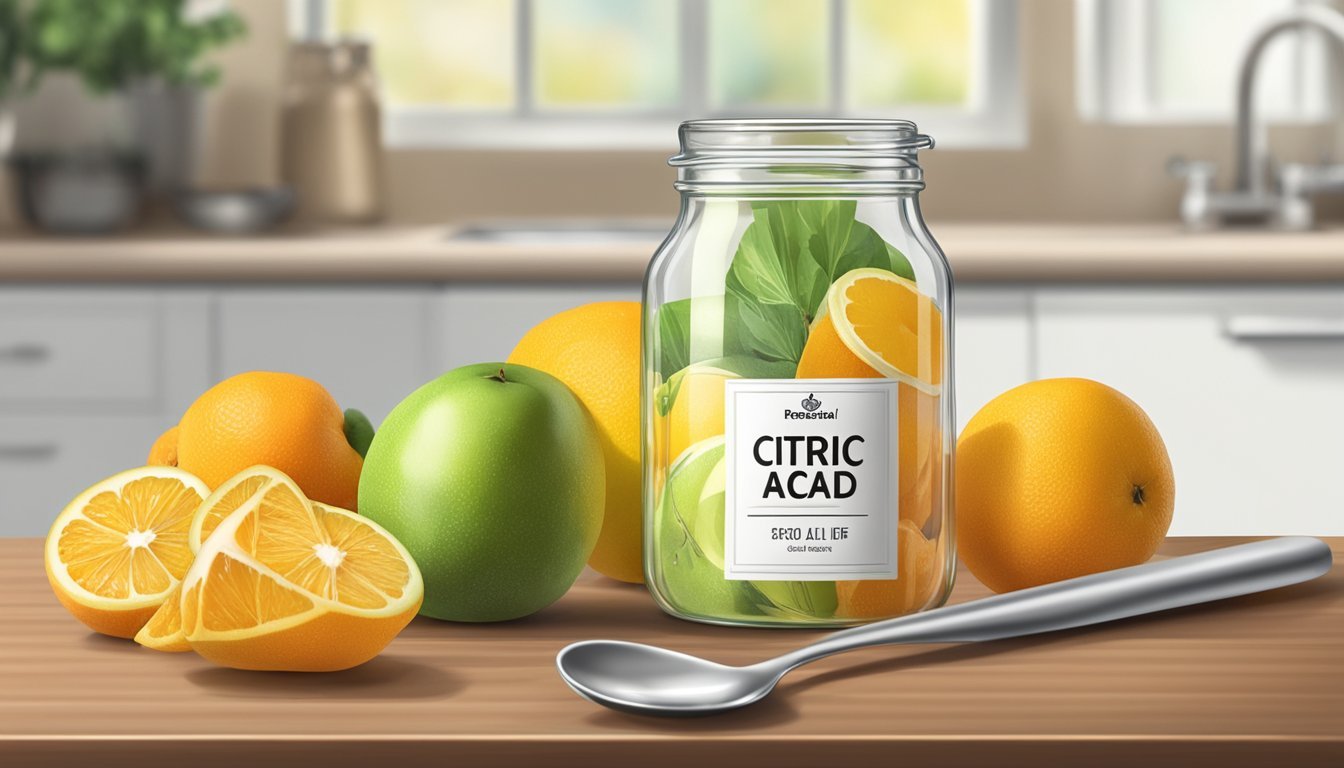How Long Does Citric Acid Last?
Shelf Life and Storage Tips
Citric acid is an organic compound known for its prevalence in citrus fruits, where it contributes to their tart flavor. Beyond its culinary uses, it is also a common food preservative and cleaning agent. This versatility raises a common question concerning its longevity: how long does citric acid last?
The shelf life of citric acid is notably extensive. In its powdered form, citric acid remains stable for years, particularly when stored correctly in a cool, dry environment, and within an airtight container. Upon opening, the acid maintains its potency, often up to five years, assuming proper storage conditions are followed.
It's important to recognize the signs of citric acid degradation, which may include changes in appearance, texture, or odor. While its expiration is rarely abrupt, its effectiveness may diminish over time, especially if exposed to unfavorable storage conditions. Diligent storage and handling are critical to preserve the quality and extend the shelf life of citric acid.
Chemical Properties of Citric Acid
Citric acid, a weak organic acid, is characterized by a distinctive sour taste and notable for its involvement in the citric acid cycle. As a foundational organic acid in biochemistry, it plays a pivotal role in the metabolic pathways of living organisms.
Stability and Reactivity
Citric acid is known for its stability as a compound when stored under appropriate conditions. This weak acid has the chemical formula C6H8O7, which corresponds to a molecular structure comprising three carboxylic acid groups (-COOH). As a result, citric acid is relatively reactive compared to other substances due to these functional groups, which can engage in various chemical reactions. These reactions include esterification, where citric acid can interact with alcohols to form citrate esters. Despite its reactivity, citric acid demonstrates a stable shelf life, not losing its efficacy quickly if kept away from moisture and in a cool environment.
Storage Conditions for Stability:
Cool environment
Dry location
Airtight container
Natural Occurrence
Occurring naturally in citrus fruits like lemons and oranges, citric acid plays a significant role in cellular metabolism in its ionized form, citrate. In nature, it is produced via a series of biochemical reactions involving the enzyme aconitase. It is also synthesized industrially through fermentation, typically using the mold Aspergillus niger, which bioconverts sugars into citric acid in a controlled environment. The utilization of Aspergillus niger in the commercial production of synthetic citric acid is due to its efficiency in converting sugars into this weak acid under specific fermentation conditions.
Usage of Citric Acid
Citric acid plays a versatile role, functioning as a flavor enhancer, preservative, and cleaning agent across various industries. Its applications are diverse, owing to its natural occurrence in citrus fruits and widespread synthetic production for commercial use.
In Food and Beverages
Citric acid is frequently used as an additive in the food industry to imbue a sour taste and maintain pH levels. It acts as a flavor enhancer in candies and carbonated soft drinks. Additionally, citric acid serves as a preservative in fruits and vegetables, keeping them fresh and preventing the growth of bacteria.
Flavoring: Adds a tart flavor to beverages and processed foods.
Preserving: Extends shelf life of fruits, including lemons, limes, oranges, and grapefruits.
In Cleaning Products
In the context of cleaning products, citric acid is appreciated for its de-scaling and water-softening properties. It is effective in removing limescale, brightening surfaces, and enhancing the cleaning power of soaps and detergents.
De-scaling: Effective against mineral deposits.
Detergent: Boosts efficacy and acts as a water softener.
In Cosmetics
The cosmetic industry harnesses citric acid for its antioxidant and pH adjusting capabilities. It is found in a variety of skin care products, where it helps to refresh skin and preserve formulations.
Skin Care: Utilized in lotions and creams for its astringent properties.
Antioxidant: Helps protect products from oxidation.
In Dietary Supplements
Citric acid supplements can provide an energy boost and augment the nutritional profile of a diet. Its inclusion in dietary supplements often targets individuals who seek to add a source of natural acid from citric fruits to their regimen.
Energy: Contributes to the metabolic process as a key acid cycle component.
Supplement: Often sold in powdered form to complement diets or as a flavoring agent.
Health and Safety Considerations
When handling citric acid, it is crucial to acknowledge both its safety as a food preservative and the potential for adverse reactions if misused. Understanding its classifications and recognizing possible side effects can ensure its responsible and safe usage.
Recognitions and Classifications
Citric acid is generally recognized as safe (GRAS) by regulatory agencies for use in food and beverages. It serves as a preserving agent to enhance longevity and maintain freshness of products. Proper storage of citric acid can further prolong its efficacy, with an unopened package lasting indefinitely and an opened one retaining potency for up to five years, ensuring long-term safety in terms of preservative qualities.
Possible Side Effects
Although rare, citric acid can cause allergies or irritation in some individuals, particularly when used in high concentrations. It is important that users avoid direct contact with eyes, as it can lead to irritation. Ingesting excessive amounts of citric acid may result in adverse effects such as digestive discomfort. Users should stick to recommended dosages to prevent adverse reactions and maintain safety standards.
Benefits of Citric Acid
Citric acid, a natural compound found in citrus fruits, plays a significant role in metabolism and offers various health benefits. It is not only integral in the Krebs cycle—a key metabolic pathway that generates energy—but also has noteworthy benefits for skin health and function.
Antioxidant Properties
Citric acid acts as an antioxidant. Antioxidants are substances that can prevent or slow damage to cells caused by free radicals, which are unstable molecules that the body produces as a reaction to environmental and other pressures. By protecting the body from oxidative stress, citric acid helps mitigate the effects of aging and can support overall metabolic health.
Impact on Skin Health
In terms of skin health, citric acid is lauded for its role as an alpha-hydroxy acid (AHA). AHAs are widely known for their exfoliating properties, which help to remove dead skin cells, promote new skin growth, and brighten the skin's appearance. Citric acid, in particular, can help to even out skin tone and soften the skin, improving its overall texture. Furthermore, its capacity to balance the skin's acidity makes it a valuable component in many skincare products.
Storage and Preservation
Citric acid's shelf life is maximized by maintaining optimal storage conditions and employing effective preservation techniques. These strategies ensure the quality and stability of citric acid over time.
Optimal Storage Conditions
Citric acid benefits from storage in a cool, dry place where temperatures are stable. Temperature fluctuations can lead to moisture buildup and, ultimately, clumping or degradation of the product. To prevent moisture and oxidation, citric acid should be kept away from direct sunlight and sources of heat. Containers should be airtight to avoid exposure to air, which can initiate oxidation and reduce the quality of citric acid.
Temperature: Storage areas should maintain a consistent, cool temperature.
Moisture: Ensure the storage area has low humidity to avoid clumping.
Sunlight: Store citric acid in an area that is not exposed to direct sunlight.
Preservation Techniques
Using proper preservation techniques will ensure that citric acid retains its potency and efficacy. Once opened, it is important to keep the container sealed when not in use. Containers must be checked regularly for signs of spoilage, which include changes in color, odor, or texture. While quality can vary by manufacturer, properly stored citric acid can generally maintain its shelf life for up to five years from the expiration date on the packaging. The key is to minimize exposure to elements that accelerate degradation.
Container: Use an airtight, opaque container to reduce air and light exposure.
Monitoring: Regularly inspect the citric acid for signs of spoilage.
Quantity: Consider repackaging in smaller quantities to limit exposure during use.
Lifespan of Citric Acid
Citric acid, an integral component in food preservation, pharmaceuticals, and cleaning agents, has an impressive shelf life when stored properly. It ensures longevity and maintains potency if conditions are optimal.
Factors Affecting Longevity
Packaging and Storage: Sealed in an airtight container, citric acid powder can remain stable for several years. The container should be kept in a cool, dry place, away from light to prevent degradation.
Humidity and Temperature: Environmental factors, such as excessive humidity and temperature fluctuations, can lead to the compound absorbing moisture, which may accelerate spoilage.
Quality of Product: The purity and the quality of the citric acid also dictate its lifespan. Higher quality products with fewer impurities may last longer.
Recognition of Expiration
Visual Changes: Citric acid that is expiring may exhibit alterations in color, becoming yellowed or clumped due to moisture.
Olfactory Indicators: Any unusual smell is a strong indicator that the citric acid is no longer potent.
Expiration Date: While citizens acid doesn't have a strict expiration date, potency can diminish over time. An opened package typically retains efficacy for up to five years, while an unopened package can last even longer if conditions are ideal.
Recognizing Spoilage
Citric acid is known for its stability and longevity, but like all substances, it can degrade over time, particularly when exposed to contaminants. The preservation of citric acid's quality hinges upon recognizing and preventing spoilage.
Signs of Degradation
Signs that citric acid is no longer suitable for use include:
Changes in Appearance: Citric acid should be white or clear in color. Discoloration, such as yellowing or the presence of visible mold, especially black mold, is a clear indication of degradation.
Texture Alterations: Citric acid is typically granular or in powder form. Clumping or a change in granularity can suggest moisture contamination.
Odor: Although citric acid naturally has a faint, sour smell, any strong or unusual odors can signal spoilage.
Effectiveness: A reduction in the expected sourness or potency when used in applications may indicate spoilage.
Prevention of Contamination
To maintain the purity and extend the shelf life of citric acid, consider:
Storage: Keep citric acid in a cool, dry environment in an airtight container. Moisture is a contributory factor to degradation and can encourage the growth of bacteria and mold.
Handling: Use clean, dry utensils when measuring out citric acid to avoid introducing contaminants.
By closely monitoring these aspects, one can ensure the citric acid remains effective and safe for use.
Citric Acid in the Environment
Citric acid plays a dual role in the environment: it is both a fundamental component in biological processes and a substance that can impact the environment when produced industrially. Understanding its environmental impact and natural degradation helps better assess its ecological footprint.
Environmental Impact of Production
Industrial production of citric acid, primarily through fermentation processes, requires considerable energy and resources. The manufacturing process involves the fermentation of sugars by Aspergillus niger, a type of fungus. This process can generate waste products, including biomass and fermentation residues, which must be managed to minimize pollution. Facilities must implement waste treatment protocols to ensure that effluents discharged into water systems do not harm aquatic ecosystems.
Waste Products from Fermentation:
Biomass
Fermentation residues
Natural Degradation Processes
In nature, citric acid is readily biodegradable and plays a significant role in the citric acid cycle, also known as the Krebs cycle. This crucial metabolic pathway present in the cells of most organisms breaks down organic compounds to produce energy. As citric acid is released into the environment, soil microbes and water inhabitants like algae and bacteria break it down, ensuring it does not accumulate to harmful levels.
Key Processes in the Citric Acid Cycle:
Aerobic Respiration: Citric acid is a key intermediate in aerobic respiration.
Energy Production: The Krebs cycle generates ATP, which cells use for energy.
By cycling through these natural processes, citric acid doesn't pose a substantial risk of environmental harm when it degrades under typical circumstances.
Historical Context and Notable Discoveries
This section delves into the origins of citric acid, tracing its discovery to the endeavors of a pioneering chemist, which laid the groundwork for its widespread use today.
Discovery of Citric Acid
Citric acid was first separated from lemon juice in 1784 by Carl Wilhelm Scheele, a Swedish chemist whose meticulous research introduced this organic compound to the scientific community. Its isolation marked a significant milestone in chemistry and paved the way for its wide-ranging applications.
Commercial Production and Supply
The commercial production and supply of citric acid are vital to various industries, especially food manufacturing. Understanding the production process and navigating supply chain issues are critical for maintaining the availability of this essential ingredient.
Production Process
Citric acid is predominantly produced through fermentation using the mold Aspergillus niger. The process begins with a carbohydrate source, such as corn syrup (how long does corn syrup last?) or sucrose, which the mold metabolizes. Controlled conditions, including optimal pH levels and temperature, are maintained to ensure efficient synthesis. The fermentation takes place in aerated stainless-steel tanks, where Aspergillus niger transforms the sugars into citric acid.
After fermentation, the citric acid is recovered through filtration and precipitation processes. It is then purified and crystallized to achieve the desired quality. This biotechnological method has allowed citric acid to be produced on a large scale, making it the most widely used organic acid in the food industry and beyond.
Supply Chain Issues
The supply chain for citric acid can be affected by various factors, from raw material availability to geopolitical events. In recent years, manufacturing shifts, such as the increase in production capacity in China, have influenced supply dynamics. Fluctuations in the demand for cleaning products and detergents, which surged during events like the COVID-19 pandemic, also impact citric acid consumption and subsequent supply.
Supply chain resilience is crucial, with manufacturers and suppliers needing to anticipate disruptions and adapt rapidly. Challenges such as transportation delays, changes in international trade policies, and raw material scarcities are persistently navigated to ensure a consistent supply of citric acid to the many industries it serves.












